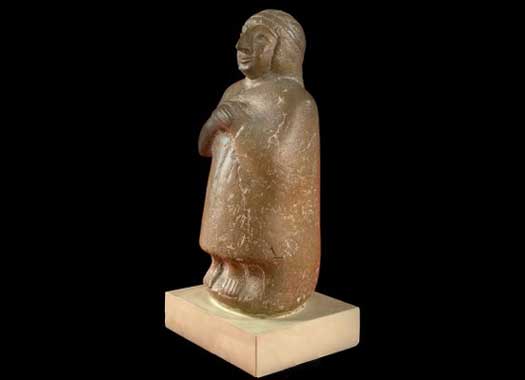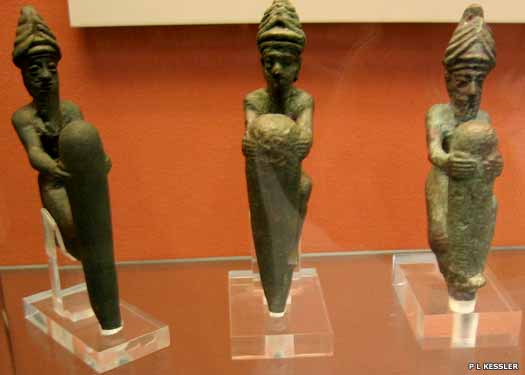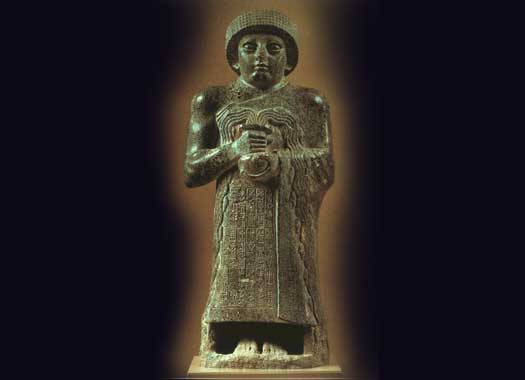
| LAGESH / SIRPURLA Lagash (modern Tell al-Hiba) was also known as Sirpurla by the Sumerians, and was located to the north-west of the confluence of the Euphrates and Tigris. Home to the E-Ninnu temple - the shrine of Nin-girsu (or Ninib, or Ninurta), the patron god of Lagash - it was one of the oldest cities in Sumer. Nearby Girsu was the religious centre for the state.
The priest-rulers (Sumerian patesis) of Lagash are suspiciously absent from the Sumerian king list. However, they are instead known from inscriptions on several important monuments from around the twenty-fifth century BC onwards. Lagash became one of the main players in Sumerian politics, alongside Ur and Uruk.
c.2550 BC :
Mesilim of Kish is famous for drawing the border between Umma and Lagash, a contentious point between these two cities. His decision, accepted by both parties, appears to favour Lagash over Umma. Mesalim sets up a steele to mark the border and builds a temple to Ningirsu in Lagash.
c.2530 BC :
Enhengal
c.2510 BC :
Lugal-Sha-Gen-Sur / Lugal-Suggur : The last of the traditional priest-kings.
c.2494 BC :
As the last of the traditional priest-kings of Lagash is replaced by Ur-Nanshe, the city becomes a major player in Sumerian politics, and the First Dynasty is founded with the throwing off of Ur's domination.
A figurine of a woman dated to Lagash at about 2500 BC First Dynasty :
While not on the king list, one extremely fragmentary supplement listing the First Dynasty has been found in Sumerian, and is known as the Royal Chronicle of Lagash. According to this, by around two hundred years after the deluge, mankind was having difficulty growing food for himself, being dependent solely on rainwater; it further relates that techniques of irrigation and the cultivation of barley were then imparted by the gods.
Only a few names can be made out on the following list of rulers, but it seems that Eannatum of Lagash conquered Ur's First Dynasty, beginning the Early Dynasty III Period in Sumer.
c.2494 - 2465 BC :
Ur-Nanshe / Ur-Nina : First king of the dynasty. Ruled for 1,080 years (RCL List).
Succeeding the ruling high priest, Ur-Nanshe is the founder of an independent dynasty which reigns at Lagash and Girsu for over a century. The king likes to commemorate his constructions, having himself portrayed in one relief as a simple bricklayer, carrying a brick basket in front of his family.
Ur-Nanshe and his successors are engaged in contests with the Elamites to the east and the kings of 'Kengi' and Kish to the north. The city's intermittent wars with Akshak during this century probably also start at this point.
c.2464 - 2455 BC :
Akurgal : Son. Possibly killed by Ensi Ush of Umma.
c.2455 - 2425 BC :
Eannatum : Son. Founded the first empire. 'He who subjects the lands.'
Eannatum annexes virtually all of Sumer, including Kish, Nippur, Uruk (briefly), Ur, and Larsa, and reduces his arch-rivals at Umma, eighteen miles away, to a tributary state with the defeat of Enakalle. In addition, he extends his realm to parts of Elam and along the Persian Gulf, apparently using terror as a matter of policy. The Stele of the Vultures describes the violent treatment meted out to his enemies. Urur of Akshak leads a northern coalition against him but that is destroyed, with Akshak recognising Lagash's supremacy along with Mari.
Lagash is later eclipsed by Umma under Lugalzaggesi. Lagash is never again a great power.
c.2430 BC :
Lugalure of Uruk helps Lagash to defeat Umma after the latter launches an attack on Lagash. Eannatum raises the stele of the vultures in place of Mesilim's destroyed stele.
c.2425 - 2405 BC :
Enannatum / Inannatum I : Brother. High priest.
Urlumma of Umma drains the boundary canal at Girsu and destroys shrines there, forcing Enannatum to defend the religious centre by offering battle at Ugigga, in the fields near Girsu. Urlumma is totally defeated and flees, only to be killed at Umma. Enannatum establishes a vassal ruler at Umma but he, too, proves to be hostile to Lagash.
c.2405 - 2375 BC :
Entemena : Son. King. Last great ensi of Lagash.
c.2375 - 2365 BC :
Enannatum / Inannatum II : Son.
c.2365 - 2359 BC :
Enetarzi : Usurper and oppressor. Either a priest or was installed by them.
c.2359 - 2352 BC :
Lugalanda : Another oppressor. Helped to the throne by the priesthood.
c.2352 - 2342 BC :
Urukagina / Uruinimgina : Usurper. Dated to c.2700 BC in older chronologies.
c.2342 BC :
Urukagina destroys much of the old bureaucracy, ending the influence of the priests. He creates a near-idyllic state, but in the process weakens Lagash to the point that it cannot (or will not) defend itself from its mortal enemies in Umma. Lugalzaggesi of Umma sacks Lagash and burns all of its holy temples. Urukagina flees to the town of Girsu, which doesn't seem to have fallen to Umma, and disappears from history.
c.2330 - 2193 BC :
Lagash loses its independence to Sargon I's Akkadian empire (which also serves to end the internecine war between it and Umma). The priest-kings become Akkadian vassals until the overthrow of the empire by the Gutians, when the priest-kings regain their independence, at least nominally.
Second Dynasty :
After the conquest of the Lagash by Agade in about 2330 BC, the priest kings eventually returned to prominence in the city. Once the Akkadian empire itself had been destroyed by the Gutians, Lagash apparently prospered, being far enough south of the Gutian base near Agade to enjoy a higher level of freedom than before.
(Additional information by Edward Dawson.)
c.2260 BC :
Ki-Ku-Id
c.2254? BC :
Lagash plays a part in Uruk's revolt against the Akkadian empire.
Foundation figures of Gudea, who was an energetic builder of temples. The peg figurines were placed in the foundations and commemorate the ruler's piety c.2250 BC :
Engilsa
c.2230 BC :
Ur-A
c.2200 BC :
Lugalushumgal
Puzer-Mama
c.2193 BC :
Sumer is overwhelmed by an invasion of Gutians. They set up base near Agade and rule as overlords from there.
Ur-Utu
Ur-Mama
Lu-Baba
Lugula
Kaku / Kakug
c.2164 - 2144 BC :
Ur-baba / Ur-bau : (On some lists Ur-Bau founds a third dynasty in Lagash).
c.2144 - 2124 BC :
Gudea : Son-in-law.
Gudea rises to local prominence during an apparent climate-induced collapse in the region, promoting artistic development and continuing the Akkadian kings' claims to divinity from his capital at Girsu. The figurine (below) of Gudea is, however, an interesting one.
It is beardless, while the name itself appears to contain the root 'gut-' which also forms the name of the Gutians - possibly coincidentally or perhaps in tribute. Who would be beardless, though? Mesopotamians all seem to be bearded in this period. Any potential Indo-European involvement in the Gutians would be bearded. An Egyptian would probably be bearded (but not always). Could Gudea have had an Egyptian parent? Or, dare it be said, is Gudea a woman?
A figurine of Gudea of Lagash, who came to prominence in southern Mesopotamia, for the most part outside of direct Gutian rule but still subject to its influence However, Sumer is still subject to Gutian rule. After Gudea, the city of Lagash appears to lose its importance and almost completely fades from historical view.
c.2124 - 2119 BC :
Urningirsu : Son. Last vassal of the Gutians. Sometimes Ur-Ningursu II
c.2119 - 2117 BC :
Pirigme / Ugme : Brother.
c.2117 - 2113 BC :
Ur-GAR : Possible vassal of Uruk.
c.2113 - 2110 BC :
Nammahani / Nammakhni / Namhani : Son-in-law. Also ruled Umma.
Nammahani co-operates fully with the Gutians before their final expulsion and possibly in their attempts to re-invade. He is considered a traitor to Sumer and he is eventually killed by Ur-Nammu of Ur. The final four kings are all vassals of Ur.
c.2090 - 2080 BC :
Ur-Ninsuna : (On some lists Ur-Ninsuna founds a fourth dynasty in Lagash).
c.2080 - 2070 BC :
Ur-Nikimara
c. 2070 - 2050 BC :
Lu-Kirilaza
c.2050 - 2023 BC :
Ir-Nanna
c.2023 BC :
Ir-Nanna declares independence from a steadily declining Ur. The king may continue to rule for some years afterwards but there are no records to show it. It seems likely that Lagash falls to Isin when that city assumes control of most of central Sumer.
Amorite Rulers of Lagash :
The Amorites had been inhabitants of Sumer for some centuries, and rose to fill the gap left by the end of Sumerian civilisation.
c.2004 BC :
When the Elamites conquer Ur, they also take control of much of Sumer for a short period.
c.1998 BC :
Lagash falls under the control of Isin when the latter captures Ur.
c.300 - 250 BC :
The remains of the E-Ninnu temple are razed to the ground and a fortress is built upon its ruins. Amid traces of the earlier temple built by Gudea, with bricks still bearing their cuneiform inscriptions, some newer bricks bear an inscription in Aramaic and Greek of a certain Hadad-nadin-akhe, ruler of a small, late Babylonian kingdom. This is within territory that had been part of the Seleucid empire since 305 BC. The date is corroborated by Greek coins at the site mentioning the kings of Characene (a district situated on the east bank of the Tigris, not very far from the junction with the Euphrates).
fl c.275 BC :
Hadad-nadin-akhe / Hadadnadinakhe : A king of Characene.
Source :
https://www.historyfiles.co.uk/ |


